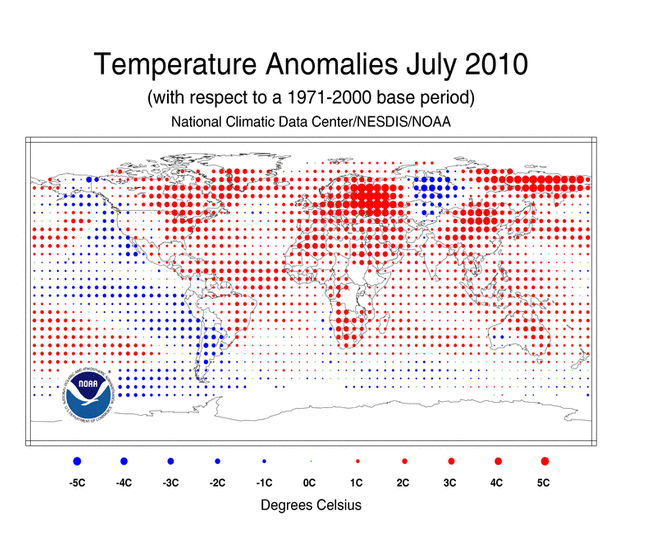25 August 2010
Blocked-up weather behind Russia's heat, Pakistan's floods
Posted by Michael McFadden

Map of temperature anomalies for July 2010. Anomalies are calculated relative to the period 1971-2000. Source: Climate Data Center/NESDIS/NOAA.
The Russian heat wave this summer that has killed an estimated 15,000 thousand is undoubtedly tied to an unusual but not unheard of event known as “blocking,” say experts on the atmosphere. And the heaviest monsoon downpours in Pakistan’s history, causing floods that have displaced more than 10 million people, may be due in part to this same blocking event.
A blocking event happens when an area of high pressure air forms that is strong enough to stop the normal flow of the west-to-east jet stream, and that stays in one spot.
In an unpublished preliminary study, David Barriopedro, an atmospheric physicist at the University of Lisbon in Portugal, says that there has been a blocking high pressure over western Russia during most of July and into early August.
He says this summer’s block was “impressive” because this phenomenon is rare in the summer, and doesn’t tend to last so long. The block over Russia was “particularly strong and persistent.”
“For the whole record I have since 1948, this has been the longest blocking on record,” at 34 days, Barriopedro says. “And the intensity, the high pressure, is probably the strongest blocking event on record.”
Normally at this time of year, a long, thin stream of fast-moving air, known as the polar jet stream, flows from west to east, across Europe and Russia. But with this summer’s blocking, the jet stream instead split into two branches. A northern branch took a detour into the Arctic, cooling down there before turning south again—and turning the summer in central Russia and Kazakhstan much colder than usual.
The other branch of the jet stream pushed south, across the Mediterranean Sea, and the two branches reconnected in the area around northern Pakistan. At the same time that Moscow was baking, Pakistan’s mountains in the north were deluged with the strongest monsoon in 80 years, by some accounts. Bridges built under the British were wiped out, and flash floods devastated villages. As the rains moved south, and the water flowed downstream, Pakistan suffered the worst floods in its 63-year history as an independent nation.
“The blocking could have enhanced the rain over Pakistan,” Barriopedro says. “The strongest period of blocking, at the end of July, was during the strongest period of rain.”
Blocking may have played a key role in severe heat waves before, like those that struck Europe in 2003, when more than 35,000 people died, and also in 1972. But whether we should expect more of these, or less, as the planet gets warmer, it’s hard to tell. Part of the problem is that we don’t understand the dynamics behind blocks, Barriopedro says.
Also, the global climate models used for simulating continued global warming generally don’t have high enough of resolution to simulate blocking events realistically, Barriopedro says. In these models, there are fewer blocking events, and they’re shorter, than in real life. “There haven’t been too many studies on blocking and climate change because of this problem,” he adds.
The preliminary results suggest that there may be little change, or perhaps a small drop in blocking events in a warmer world. However, blocking events could have stronger effects. “In a warmer world, the consequence of [summer blocking] is much stronger,” because the higher average temperatures raise the bar.
With newer climate models, we may be able to get a better sense of what’s in store.
A team at Japan’s Meteorological Research Institute in Tsukuba has recently used the Earth Simulator, one of the world’s most powerful supercomputers, to run higher-resolution climate models to look for the development of blocking events and how they’ll change in a warmer world.
In two studies published in American Geophysical Union journals in the past two years, the Japanese team’s models suggest that continued global warming will lead to a significant drop in wintertime blocking events over Australia, and in the northern Pacific and northern Atlantic oceans. It’s too early to be confident that these predictions will turn out to be right, Barriopedro says, but the development of these models are definitely on the right track.
– Mason Inman, contributing science writer










 GeoSpace is a blog on Earth and space science, managed by AGU’s Public Information staff. The blog features posts by AGU writers and guest contributors on all sorts of relevant science topics, but with a focus on new research and geo and space sciences-related stories that are currently in the news.
GeoSpace is a blog on Earth and space science, managed by AGU’s Public Information staff. The blog features posts by AGU writers and guest contributors on all sorts of relevant science topics, but with a focus on new research and geo and space sciences-related stories that are currently in the news.
t’s hard to find knowledgeable people on this topic, but you sound like you know what you’re talking about! Thanks